
- Index
- Assembly Status
- Brand
- Antique (36)
- Baker (122)
- Century (30)
- Chippendale (16)
- Drexel (23)
- Ethan Allen (77)
- Harden (15)
- Henkel Harris (75)
- Henredon (36)
- Kindel (22)
- Kittinger (45)
- Lane (39)
- Maitland Smith (19)
- Pennsylvania House (25)
- Stickley (51)
- T.o.p. (17)
- Table (156)
- Thomasville (30)
- Unknown (69)
- Vintage (40)
- Other (2646)
- Item Length
- Material
- Bamboo (25)
- Brass (76)
- Brass, Cherry (34)
- Brass, Mahogany (49)
- Brazilian Mahogany (17)
- Burr Walnut (33)
- Burr Yew Tree (13)
- Cherry (132)
- Cuban Mahogany (14)
- Glass (31)
- Leather (31)
- Mahogany (1396)
- Mahogany, Wood (48)
- Marble (29)
- Oak (62)
- Rattan (18)
- Rosewood (33)
- Walnut (161)
- Wood (316)
- Yew (13)
- Other (1058)
- Shape
- Type
- Accent Table (211)
- Bank Of Drawers (38)
- Card / Game Table (25)
- Chairs (23)
- Coffee Table (290)
- Console Table (184)
- Desk (34)
- Dining Table (407)
- Drop Leaf Table (51)
- End & Side Tables (55)
- End Table (223)
- Game Table (62)
- Nightstand (38)
- Side / End Table (114)
- Side Table (157)
- Side Tables (42)
- Table (201)
- Tables (156)
- Tea Table (124)
- Tilt Top Table (33)
- Other (1121)
Extremely Rare Nest Of Emile Galle Circa 1900 Specimen Wood Tables Art Nouveau
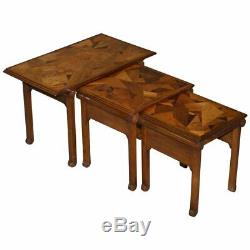
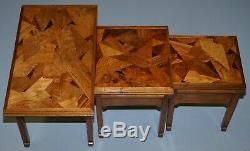
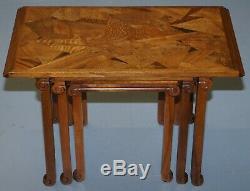
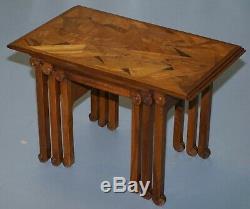
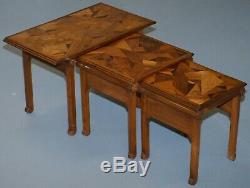


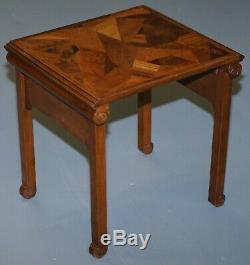
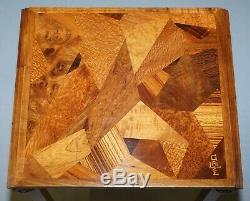
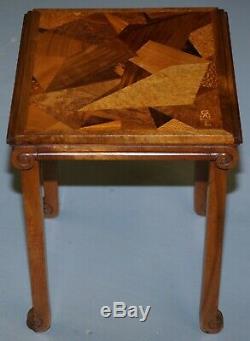
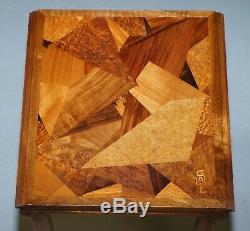
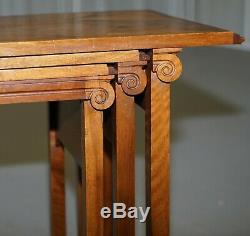


There are around 50-100 high definition super-sized pictures at the bottom of this page. If you are looking at this listing then the chance are you know who Galle is and are familiar with his work, if not please find below a brief history on the great man. These tables are based in satinwood, the tops are all very rare cuts of sample wood, each table is signed in wood Galle, they are the finest of this type you will ever see. The tables have been restored to include a light refinishing, there was a scratch on the second table top, they are nearly 120 years old so some patina marks are to be expected. He later learned glassmaking at Meisenthal and came to work at his father's factory in Nancy following the Franco-Prussian War.
His early work was executed using clear glass decorated with enamel, but he soon turned to an original style featuring heavy, opaque glass carved or etched with plant motifs, often in two or more colours as cameo glass. His friend and patron Robert de Montesquiou sent him to Bayreuth with a recommendation to Cosima Wagner, which led to a great enthusiasm for Parsifal. In 1877, he then assumed his fathers role as director of the Maison Gallé-Reinemer.
In that same year, he was elected Secretary-General for the Société centrale dhorticulture de Nancy. His career took off after his work received praise at the Paris Exhibition of 1878. Within a decade of another successful showing at the Paris Exhibition of 1889, Gallé had reached international fame and his style, with its emphasis on naturalism and floral motifs, was at the forefront of the emerging Art Nouveau movement. He continued to incorporate experimental techniques into his work, such as metallic foils and air bubbles, and also revitalized the glass industry by establishing a workshop to mass-produce his, and other artists', designs. The factory would employ 300 workers and artisans at its height, including the notable glassmaker Eugène Rosseau, and remained in operation until 1936.Gallé wrote a book on art entitled Écrits pour l'art 1884-89 ("Writings on Art 1884-89"), which was published posthumously in 1908. What is less well-known is Gallé's social engagement. He was a convinced humanist, and was involved in organizing evening schools for the working class (lUniversité populaire de Nancy). He was treasurer of the Nancy branch of the Human Rights League of Franceand in 1898, at great risk for his business, one of the first to become actively involved in the defence of Alfred Dreyfus. He also publicly defended the Romanian Jews and spoke up in defence of the Irish Catholics against Britain, supporting William OBrien, one of the leaders of the Irish revolt.
In 1901, together with Victor Prouvé, Louis Majorelle, Antonin Daum and Eugène Vallin, he founded an Art Nouveau movement known as École de Nancy (The Nancy School). Many of Gallé works are kept at the Musée de l'École de Nancy. Please note all measurements are taken at the widest point, if you would like any additional or specific measurements please ask. This item is available for collection from our Wimbledon warehouses SW19-3BE, we can have it delivered nationwide to include Scotland Wales and Ireland. Wimbledon-Furniture is a privately owned family ran business out of Wimbledon SW19, we have four large storage warehouses, if you have any questions my number is under the business sellers information, please feel free to call or text. Please view the very detailed pictures as they form part of the description around condition. Please note vintage period and original items such as leather seating will always have natural patina in the form of cracking creasing and wear, we recommend regular waxing to ensure no moisture is lost, also hand dyed leather is not recommended to sit in direct sunlight for prolonged periods of time as it will dry out and fade. COURIER (LARGE ITEMS ONLY THAT CANT BE POSTED).Whoever delivers will always require help on the larger items to unload, the price you will be quoted will always be based on this assumption, if this is not possible please let us know as it will affect the price to send a two man team. The item "EXTREMELY RARE NEST OF EMILE GALLE CIRCA 1900 SPECIMEN WOOD TABLES ART NOUVEAU" is in sale since Tuesday, April 30, 2019.
This item is in the category "Antiques\Antique Furniture\Tables\Victorian (1837-1901)". The seller is "wimbledon-furniture-01" and is located in London Wimbledon. This item can be shipped worldwide.- Style: Adams
- Material: Wood
- Original/Reproduction: Original
- Type: Nested Tables

